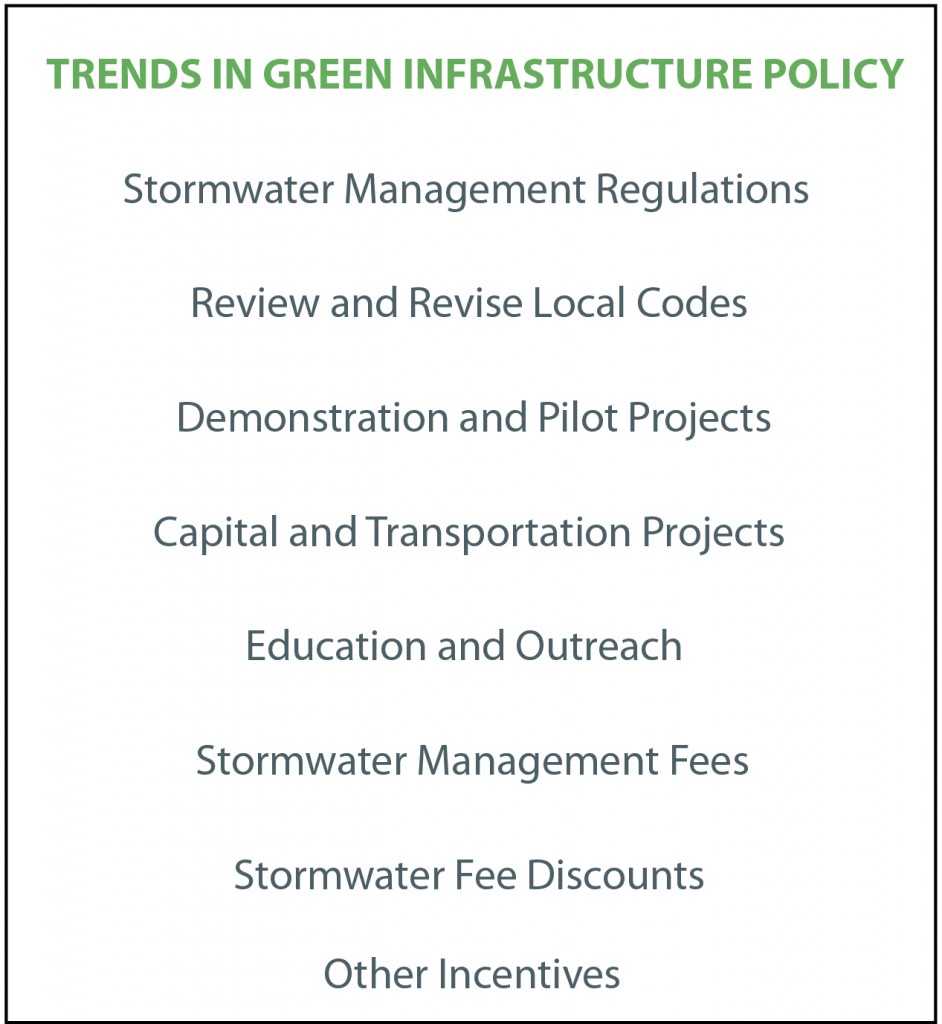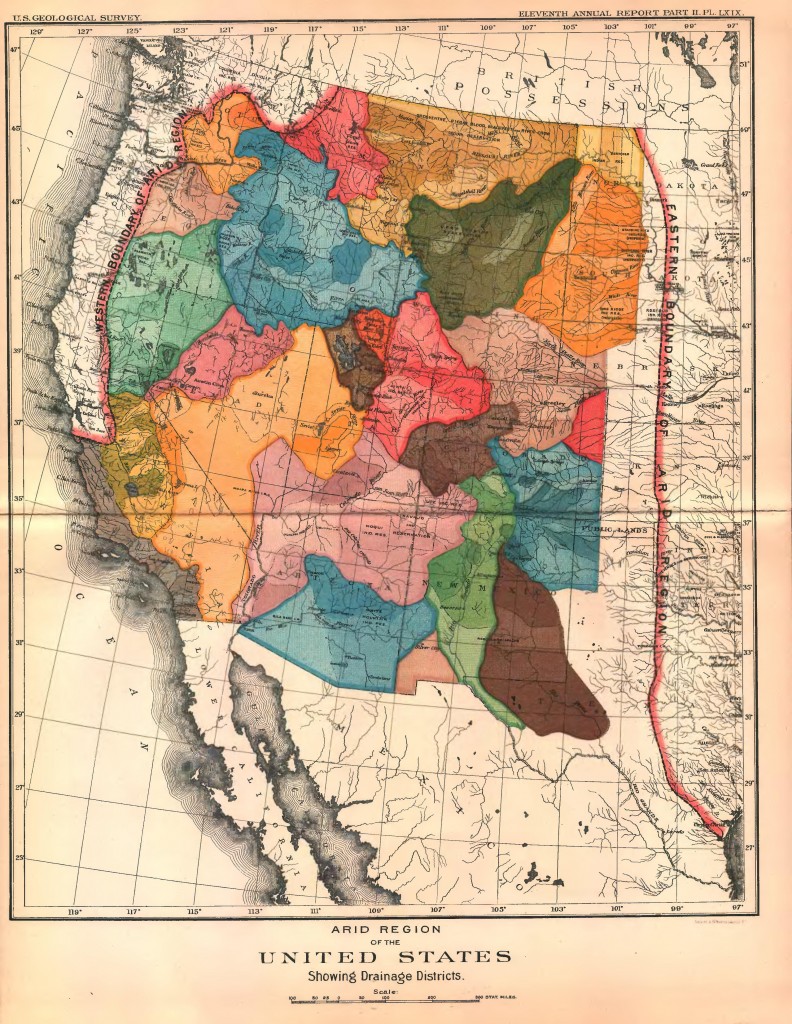Based on a high level review of green infrastructure literature (GI) and GI policy, it became clear that much of the existing green infrastructure policy is at the local level (city and county). Additionally, based on the literature reviewed, communities integrating green infrastructure policies are doing so as a creative and sustainable way to comply with state and federal stormwater management regulations, while improving community livability. Communities across the country are utilizing GI policy to comply with Federal level policy such as the National Pollutant Discharge Elimination System (NPDES), Municipal Separate Storm Sewer Systems (MS4), Combined Sewer Overflow (CSO), and Total Maximum Daily Loads (TMDLs).
While GI policy can be used to comply with Federal level regulations, overlap exists when communities use GI to also provide economic, community and environmental benefits. Places like Portland, OR, utilize both green infrastructure policies and programming to achieve more economically competitive, livable and environmentally friendly communities. Additionally, Portland implements ecoroofs, green streets and incorporates gi in new and retrofit projects among other areas. Another great example comes from a public/private partnership between the Village of Niles, IL, and Coca Cola. The two partnered with the help of local businesses and community volunteers to design and build a 2,754 square foot rain garden with native plants. Not only did this project engage and inform the community, but now the Village of Niles is working toward integrating more GI policies and practices into their stormwater policies and plans.
These are only two examples of the innovative ways that GI is being incorporated not only into policy, but our built environments to improve community quality of life. An important note about the integration of GI policy is that it is not one size fits all. GI interventions that may work in Seattle, WA, may not work in Albuquerque, NM. Additionally, there is no one approach to GI and for GI to be successful, it needs to be incorporated on a number of different levels, which will be discussed in the next section.

The US EPA conducted a comprehensive green infrastructure policy review in Green Infrastructure Case Studies: Municipal Policies for Managing Stormwater with Green Infrastructure. This document identifies nine categories of green infrastructure policy and highlights a number of case studies throughout the United States incorporating these policies. The US EPA found that most cities and counties incorporating green infrastructure policies in their communities are doing so by integrating and blending one or all the nine categories in the public and private sectors. Based on the green infrastructure literature reviewed, these nine categories of green infrastructure policy commonly reappeared. Instead of reinventing the wheel, the green infrastructure case studies and discussion of GI policy on this site are organized based on those nine categories, which can be seen in the chart at left.
Stormwater Management (SWM) Regulations - Communities are using GI within their city and county SWM regulations to comply with the Clean Water Act (CWA). While integrating GI within SWM regulations serves as a positive step, the US EPA notes that this practice alone is not enough to achieve the maximum benefits because these regulations only impact new development/permits and not existing (p.13).
Review and Revise Local Codes - According to the US EPA, reviewing and revising existing local codes may be necessary in order to align existing policies and to eliminate barriers to integrating green infrastructure policies may be necessary (p.17). Ensuring that a community’s land use plan and zoning ordinances do not impair a stormwater management plan is critical.
Demonstration and Pilot Projects - Creating GI demonstration projects is a great way to educate the local elected officials, constituents and other stakeholders about GI. As mentioned previously, the Village of Niles decided to incorporated more GI policy in their local plans after the positive response to a rain garden.
Capital and Transportation Projects - A great example of integrating GI into capital and transportation projects would be a road retrofit. A road diet that integrated curb bulb outs with native green features to detain and absorb stormwater would not only slow cars and create a more aesthetically pleasing, walkable environment, but would be good for the environment.
Education and Outreach - The use of education signage at GI demonstration and pilot projects can help to not only inform, but engage the community. Environmental education components can also serve as a call to action for residents to do their own part in reducing stormwater runoff.
Stormwater Management Fees - According to the US EPA, SWM fees “generate a dedicated revenue stream” for CSOs, stormwater runoff or to maintain other infrastructure.
Stormwater Management Discounts - SWM discounts give property or business owners a discount on SWM fees for specifically defined changes on their properties to improve the management of swm runoff.
Other Incentives - According to the US EPA, local governments can create different strategies to incentivize GI practices on private properties (p. 23). For example, the city could choose to streamline permits for projects that incorporate GI practices.
There are other planning related policy areas that can be used to integrated green infrastructure. Those areas include: Smart Growth, New Urbanism and Context Sensitive Solutions. Additionally, GI can be incorporated into long range transportation plans at the regional scale.
History of Green Infrastructure
To be able to understand the present and future of green infrastructure (GI) policy, it is important to have an understanding of where we have been. While this timeline is not exhaustive of every event that informed and shaped green infrastructure policy, it highlights important and significant events to paint a clearer picture of the shapers of green infrastructure policy today. Green infrastructure and green infrastructure policy are not new concepts and looking back in history, the important relationship between humans and green spaces and places becomes more apparent.
Since it is at the Federal level where policies that govern natural resources on a local level are created, this timeline focuses on Federal level legislation as it relates to GI. In recent years, the US EPA started advocating for the use of GI as a strategy to improve SWM and improve water quality. They released a number of memos, which can be found HERE.

Scale

John Wesley Powell’s Drainage District Map, 1890, Source: http://www.aqueousadvisors.com/powellmap.pdf
If we had implemented John Wesley Powell’s way of thinking, the United States that we know today may look very different and we would be planning our communities in very different ways. Powell thoroughly explored the arid Southwest starting in the 1860s and was the first documented European American to travel through the Grand Canyon (Source). Based on his travels and knowledge, Powell felt water would be a continuing problem in the arid West. In 1890, he proposed drainage districts (watershed districts) that would each govern themselves. (Source).
But today we are guided by boundaries of states, counties and cities. The chart below demonstrates different scales of green infrastructure. Under the main headers of National, State, Regional, County, City, Neighborhood and Site are the resources at that level. The bullet points are the related planning and/or regulatory activities at that scale.

This GI scale shows national level policy and how it trickles down to the local level.
